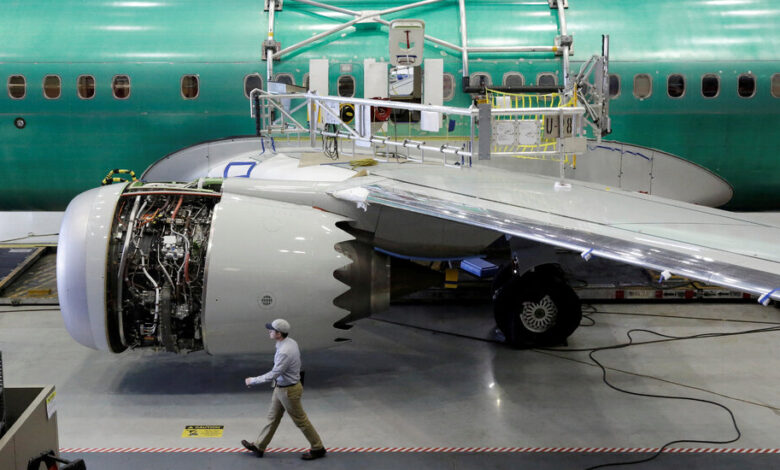Boeing, Still Recovering From Max 8 Crashes, Faces a New Crisis

After two deadly crashes involving its best-selling 737 Max 8 planes five years ago, Boeing spent billions of dollars to make its products safer and repair its reputation. Now, the company is again confronting a wave of uncertainty and costs following a harrowing incident involving a different 737 jet.
Just four weeks ago, a hole blew open on a 737 Max 9 jetliner during an Alaska Airlines flight shortly after takeoff when what appears to have been a poorly attached panel tore away. The Alaska pilots made an emergency landing as terrified passengers feared the worst.
The incident has prompted the Federal Aviation Administration to indefinitely halt Boeing’s ambitious plans to raise production of Max planes. Passengers have filed class-action lawsuits against the company. And some infuriated airline executives are taking the rare step of criticizing Boeing publicly and expressing doubt about its ability to deliver planes when they were expected. The chief executive of United Airlines has gone so far as to suggest that his company might cancel some of its orders with Boeing.
A case the company settled with the federal government for $2.5 billion in the waning days of the Trump administration to avoid prosecution could be reopened if the Justice Department determines Boeing did not comply with the terms of the deal.
Boeing referred questions about that agreement to the Justice Department. A representative for the agency did not immediately respond to a request for comment.
Compounding problems for Boeing, the company said on Sunday that a supplier had found a new problem with fuselages on dozens of unfinished 737 Max planes. In a note to employees, Stan Deal, the chief executive of Boeing’s commercial plane unit, said that the supplier last week identified that “two holes may not have been drilled exactly to our requirements.”
He did not name the supplier. But a spokesman for Spirit AeroSystems, which is based in Wichita, Kan., and makes fuselages for the Max, said that a member of its team had identified an issue within the past week that did not conform to engineering standards.
Mr. Deal said that the problem was “not an immediate flight safety issue” but that it would force the company to rework about 50 planes, delaying their delivery.
Such delays, even if they prove short, could add up over time and lead to lower profits or bigger losses for Boeing. The company lost $2.2 billion last year after losing $5 billion in 2022.
There is so much uncertainty surrounding Boeing that its executives last week declined to provide a financial forecast for this year.
“Now is not the time for that,” Boeing’s chief executive, Dave Calhoun, told Wall Street analysts on Wednesday. “We won’t predict timing. We won’t get ahead of our regulator. We will go slow to go fast.”
Since the Alaska Airlines incident, which occurred on Jan. 5, shares of Boeing have fallen about 16 percent as of the end of last week. They were down about 2 percent on Monday morning after news of the delayed deliveries of the 50 Max jets.
Stewart Glickman, an analyst for CFRA Research, said Boeing could lose more market share to its main rival Airbus and even to much smaller manufacturers like Embraer if the company’s manufacturing processes “are not ironed out.”
When the panel, known as a door plug, blew off the Alaska Airlines plane, Boeing had not yet fully recovered from its last crisis: the 737 Max 8 crashes that killed nearly 350 people in Indonesia in October 2018 and in Ethiopia in March 2019.
In a financial filing Wednesday, the company reported having paid $400 million to 737 Max customers in 2023, after paying $1 billion in 2022. All told, those two crashes and the grounding of the Max 8 for nearly two years cost Boeing about $20 billion.
Ronald Epstein, senior aerospace and defense analyst at Bank of America Global Research, estimated that the Alaska incident and its ripple effects — such as penalties and expenses related to oversight — could ultimately cost Boeing’s 737 Max program $1 billion.
Mr. Epstein highlighted several factors that have contributed to the murky outlook for Boeing, including uncertainty around the company’s production system, as well as how the increased scrutiny on the Max could affect another Boeing model, the 777X, which has already suffered delays in its F.A.A. certification. He added that it was not clear when the F.A.A. would certify Boeing’s Max 7 and Max 10, which are critical pieces of the company’s production plans.
“We don’t know what the slope of the ramp is going to be,” he said. “We don’t know what the slope of production is going to be. We just don’t know.”
Before the Max 8 crashes, Boeing was producing around 52 planes per month. The pandemic ground manufacturing to a halt, but the company had been slowly regaining momentum. By the end of last year, the company said it was producing 38 Max planes a month; it had said it planned to increase its production to 42 planes per month this year, and to about 50 in 2025. But the F.A.A.’s directive has halted those plans, possibly for many months.
Further complicating Boeing’s path to recovery is a smaller and less experienced work force than it had before the pandemic. Like it often does when the economy slows, the company laid off, furloughed and bought out many experienced workers. When production restarted, Boeing had to hire or rehire workers.
But this time, like other companies, Boeing has not been able to bring back many of the experienced workers that left during the pandemic, according to Jason Gursky, an analyst at Citi who follows Boeing. Solving the work force issue, Mr. Gursky said, will be instrumental in increasing production.
Another potential problem for the company is that travelers could become more fearful of flying its planes.
Unlike the Max crashes, which were caused by a flaw with the aircraft’s flight-stabilizing system, the Jan. 5 incident appears to be the result of a manufacturing error. Employees at Boeing’s Renton, Wash., factory appear to have opened and reinstalled the door plug that later blew off at 16,000 feet. The National Transportation Safety Board is set to release a preliminary report about the incident in the coming days.
The distinction between design and manufacturing flaws may not matter to passengers. A January poll from YouGov and The Economist found 29 percent of Americans positively rated the safety record of the Boeing 737 Max 9, while 32 percent rated it negatively; 40 percent said they did not know.
Mr. Gursky, the Citi analyst, said the key to Boeing’s recovery from its latest setback was simple: a return to “basic business” by following the guidance handed down by regulators, along with hiring more workers and avoiding bad publicity. After all, he said, most passengers are not attuned to the make of plane they are flying.
“People don’t know whether they’re hopping on a Boeing aircraft or an Airbus aircraft when they get onto it,” Mr. Gursky said. “You don’t know until you until you get the safety card out of the seat pocket in front of you.”
Richard Aboulafia, a managing director at AeroDynamic Advisory, an aerospace consulting firm, said he was not worried about the company’s financial strength but was concerned that the company was not doing enough to fix its challenges.
“There’s only one uncertainty, which is whether or not they will change to avoid irrelevance and possibly worse,” he said.



